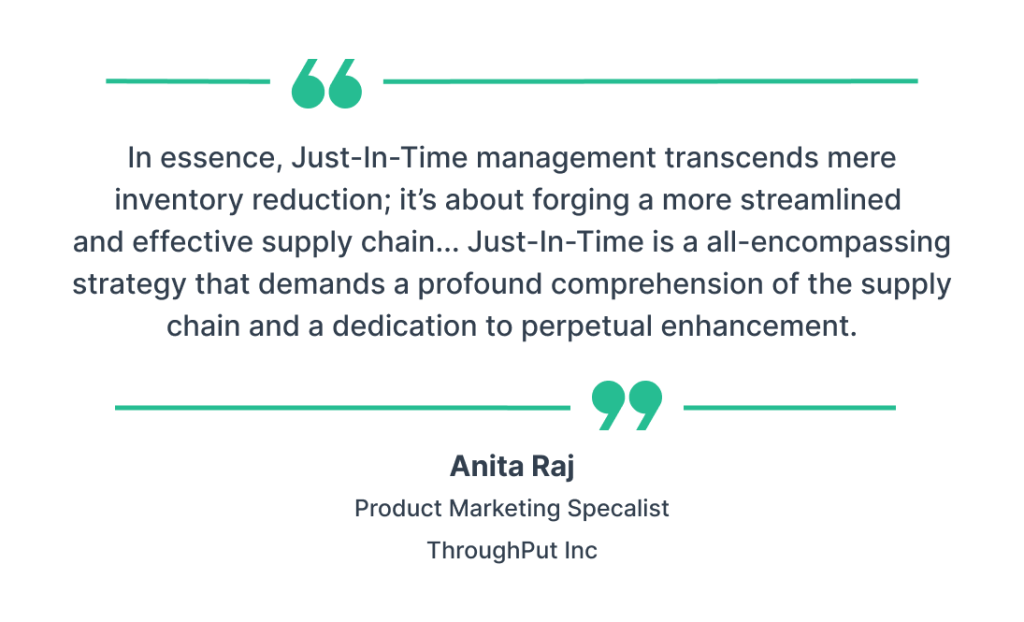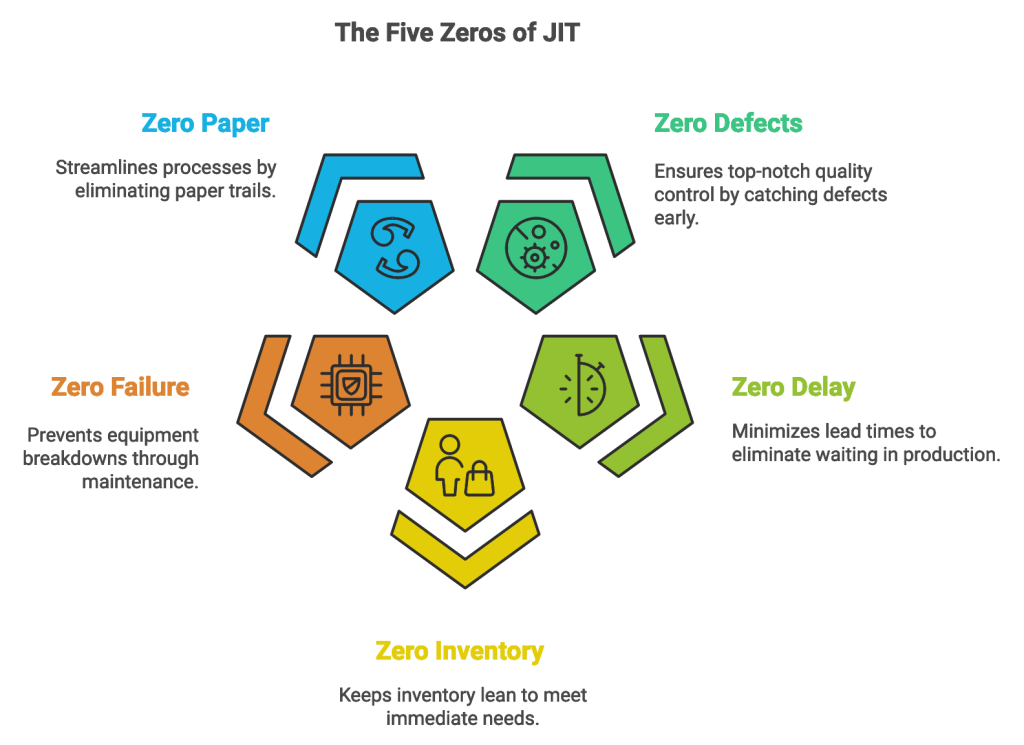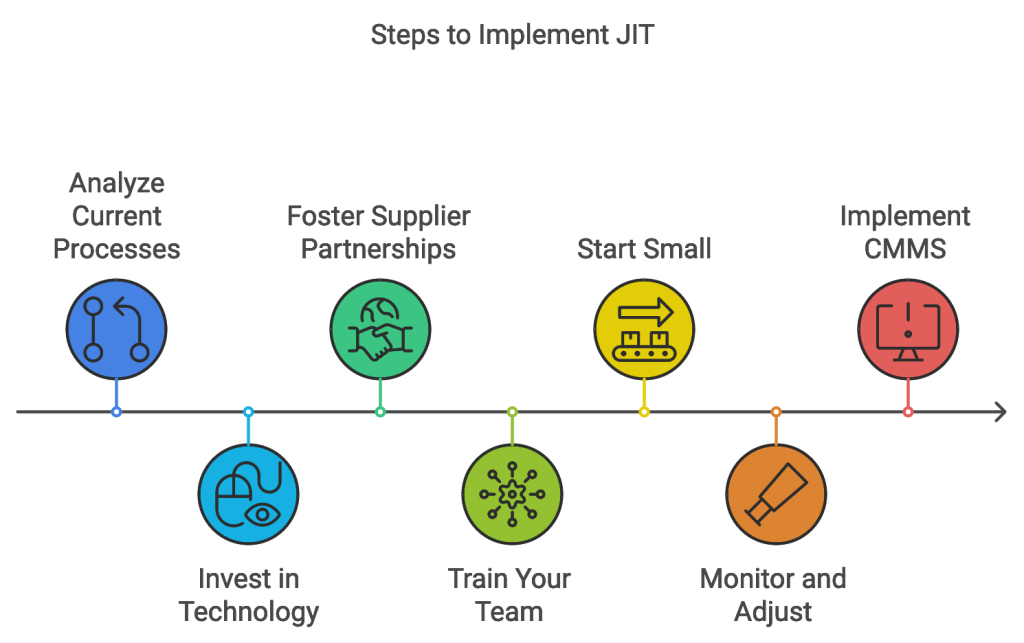Get a Free WorkTrek Demo
Let's show you how WorkTrek can help you optimize your maintenance operation.
Try for freeToday, we’re diving into the world of inventory management to explore a game-changing strategy called Just in Time or JIT. If you’re looking to optimize your business, cut costs, and keep your customers happy, JIT might be your new best friend. Let’s break it down!
What is JIT Inventory Management?
Have you ever wondered how companies have enough products to meet demand without stocking up their warehouses?

Illustration: WorkTrek / Quote: ThroughPut Inc
A just-in-time (JIT) inventory system is all about getting the right materials in the right quantities at the exact right time—no sooner, no later. The goal is to minimize inventory and reduce waste and inventory holding costs, boosting efficiency across your supply chain.
Here’s how it works: instead of stockpiling tons of raw materials or finished products, you align your orders with production schedules so everything arrives when needed. No more excess inventory taking up valuable space and tying up cash!
Why Use JIT?

Source: WorkTrek
So what’s the big deal with JIT? Why are companies around the globe adopting this approach for their production process? Here are a few key benefits:
1. Lower Inventory Costs: By keeping inventory lean, you spend less on storage, insurance, and potential write-offs of obsolete stock. More money in your pocket!
2. Improved Cash Flow: With less capital tied up in inventory, you free up cash for other areas of your business. Hello, growth opportunities!
3. Enhanced Efficiency: JIT encourages streamlined processes and tight coordination with suppliers. The result? A well-oiled supply chain machine.
4. Better Customer Responsiveness: When excess inventory doesn’t slow you down, you can pivot quickly to meet changing customer demands and improve customer satisfaction. Talk about agility!
How Does JIT Work?
Alright, let’s get into the nitty-gritty of how JIT functions. The process requires you to predict demand accurately and maintain communication with all the suppliers.
By focusing on reducing waste and improving workflows, JIT helps businesses meet customer demand with minimal delays and excess stock. Below, we break down the core steps of how JIT works:
1. Accurate Demand Forecasting: JIT relies on precise predictions of customer demand to determine what to order and when.
2. Tight Supplier Relationships: Close collaboration with suppliers ensures materials arrive on schedule and meet quality standards, reducing inventory waste and storage costs.

Illustration: WorkTrek / Data: procurious
3. Efficient Production Processes: Streamlined operations and minimal downtime keep the JIT engine running smoothly.
4. Continuous Improvement: JIT is all about kaizen – ongoing efforts to identify and eliminate waste for ever-increasing efficiency.
The Five Zeros of JIT
At the heart of JIT lie five core principles known as the Five Zeros. These tenets guide every aspect of the JIT philosophy:
1. Zero Defects: JIT demands top-notch quality control. The goal is to catch and correct defects before they disrupt the production flow.
2. Zero Delay: Time is money in JIT! The aim is to minimize lead times and eliminate waiting between production stages.
3. Zero Inventory: JIT’s hallmark is keeping inventory as lean as possible. The idea is to have enough materials to meet immediate needs.
4. Zero Failure: Equipment breakdowns? Not on JIT’s watch! Preventive maintenance and robust backup plans keep production humming along.

5. Zero Paper: JIT loves efficiency, and that means cutting out the paper trail. Digital systems and automation streamline communication and record-keeping.
By pursuing these Five Zeros, JIT practitioners create a hyper-efficient, waste-free environment where every resource is optimized.

Source: WorkTrek
Real-World JIT Success Stories
Enough theory, let’s see JIT in action! Check out these companies that have mastered the art of JIT:
Toyota
The granddaddy of JIT, Toyota, pioneered this approach in the 1970s. They revolutionized the auto industry by keeping inventory lean and focusing on continuous improvement and became a global leader.
Toyota is the leader in how to use this strategy effectively. They developed the Toyota Production System (TPS), which relies on JIT principles to minimize waste and keep operations efficient. Toyota saved millions in inventory costs by producing vehicles based on customer demand rather than maintaining a large stock.
Dell
Dell’s famous “build to order” model is a prime example of JIT. They keep a minimal inventory and assemble computers on demand, allowing for mass customization and reduced overhead.
Dell uses JIT to deliver custom-built computers to customers quickly. Instead of stockpiling parts, Dell orders components based on actual customer orders. This approach helps them keep costs down and avoid the risk of holding outdated inventory. This is particularly crucial in the fast-moving tech industry.
McDonald’s
You may not realize it, but every time you grab a burger at McDonald’s, you’re witnessing JIT in action. The fast-food giant has perfected the art of making food only when a customer orders it, which reduces waste and keeps food fresh. It’s why your fries are hot and crispy rather than sitting under a heat lamp for hours.
Harley-Davidson
Harley-Davidson turned to JIT to help save the company from the brink of bankruptcy. By embracing JIT, they were able to slash costs and improve manufacturing efficiency. The focus on reducing excess inventory allowed Harley-Davidson to customize orders, keep costs down, and remain competitive.
Implementing JIT in Your Business
Ready to give JIT a go? Here are some steps to get you started:
1. Analyze Your Current Processes: Identify areas of waste and inefficiency in your supply chain. This is your starting point!

Illustration: WorkTrek / Data: Caps Research
2. Invest in Technology: Tools like inventory management software and real-time data analytics are your friends in the JIT world.
3. Foster Supplier Partnerships: Work closely with your suppliers to ensure they can meet your JIT needs. Communication is key!
4. Train Your Team: Get everyone on board with the JIT philosophy. It takes a village to make it work seamlessly.
5. Start Small: Implement JIT in phases, starting with your most critical products or processes. Iron out the kinks before scaling up.
6. Monitor and Adjust: Keep a close eye on your JIT system and be ready to make tweaks as needed. Remember, continuous improvement is the name of the game!
7. Implement CMMS: By implementing a CMMS system, such as WorkTrek, you can automate parts management, receive low parts alerts, and view all your current and future work orders in real-time.

Source: WorkTrek

Challenges and Considerations
While JIT offers plenty of perks, it’s not without its challenges. JIT isn’t without risks. Because the strategy depends on precise timing, any disruption can be costly.
Delays in deliveries, sudden spikes in demand, or natural disasters can lead to production delays. Companies need to have contingency plans to handle such disruptions. Here are a few things to keep in mind:
1. Supply Chain Disruptions: JIT relies on a tightly choreographed supply chain. Any hiccups (natural disasters, supplier issues, etc.) can throw a wrench.

Illustration: WorkTrek / Data: Deloitte
2. Quality Control: With JIT, there’s little room for error. Rigorous quality control measures are a must to avoid production delays.
3. Supplier Reliability: JIT’s success hinges on your suppliers’ ability to deliver the right materials at the right time. Choose partners wisely!
4. Initial Investment: Implementing JIT often requires upfront investments in technology, training, and process improvements. But trust us, it’s worth it in the long run!
Can JIT Work for Every Business?
While JIT is fantastic for manufacturing and industries with predictable demand, it’s not always a one-size-fits-all solution.
Businesses that deal with unpredictable demand or rely on overseas suppliers might find it challenging. Imagine a toy store around the holidays — if demand suddenly spikes, and there’s not enough inventory due to JIT, that’s a missed opportunity.
In recent years, the COVID-19 pandemic highlighted some of the risks associated with JIT.
Disrupted supply chains caused significant issues for companies relying on JIT, showing that flexibility and backup planning are critical.
How AI Can Help Optimize JIT

Illustration: WorkTrek / Data: Unleashed
Artificial intelligence is becoming a game-changer for JIT inventory management. Here are some ways AI can help manufacturers optimize their JIT systems:
- Demand Forecasting with AI: AI can analyze vast amounts of data, including historical sales, market trends, and external factors, to predict demand more accurately. This precision allows companies to make better decisions about when and how much inventory to order, reducing the risk of overstocking and stockouts.
- Enhanced Supplier Management: AI can help monitor supplier performance in real-time, identifying potential delays or issues before they become critical. With AI-driven insights, manufacturers can switch to backup suppliers or adjust production schedules proactively, minimizing disruptions in the JIT process.
- Automated Inventory Tracking: AI-powered systems can automatically track inventory levels and send alerts when supplies run low. This helps ensure that companies always have enough inventory, reducing the risk of production delays.
- Predictive Maintenance: AI can also monitor equipment and predict when maintenance is needed. By preventing unexpected breakdowns, manufacturers can maintain consistent production schedules, which is essential for JIT to work effectively.
- Real-Time Analytics: AI provides real-time analytics that helps businesses respond quickly to changes in demand or supply chain disruptions. For example, if there is an unexpected surge in demand, AI can suggest adjustments to production and inventory orders to meet customer needs without causing waste.
- Supply Chain Optimization: AI can optimize the supply chain by finding the most efficient delivery routes and schedules. This ensures that materials arrive just in time, reducing delays and keeping the JIT process running smoothly.
Conclusion
Phew, that was a lot to cover! But hopefully, you now have a solid grasp of what JIT inventory management is, how it works, and why it’s such a powerful strategy for businesses of all stripes.
Remember, JIT is not a one-size-fits-all solution. It takes careful planning, execution, and ongoing optimization to reap the full benefits. But for those willing to put in the work, the rewards can be game-changing.
So go forth and JIT! Your streamlined, super-efficient future awaits.
Happy inventory optimizing!










